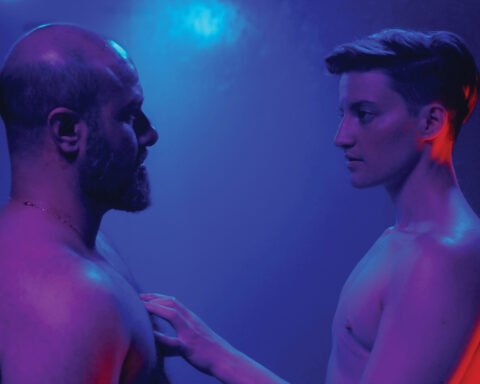Hybrid films show the endless malleability of John Grierson’s definition of documentary as “the creative treatment of actuality.” Wild performances and media-obsessed self-representations are exploding documentary’s realistic façade in an increasingly relevant response to today’s hyper-documented selfie culture. Penny Lane’s Nuts! (2016) resembles a storybook fable with its tale of a quack doctor told using a playful collage of animation and an enchanting labyrinth of lies. John Bolton’s Aim for the Roses (2016) features fragments of an old NFB film spliced between multiple performances as a chorus sings outrageous odes to two daredevils and, in turn, creates a third. Rufus Norris’s London Road (2015) also does a documentary song and dance with words taken from real-world subjects and transplanted into the mouths of recognisable stars like Tom Hardy and Olivia Colman. These hybrid films liberally combine drama and documentary to advance the particular stories they tell.
Like Toto at the end of The Wizard of Oz, these films pull back the curtain and reveal their construction. Unlike the Wizard, though, exposure doesn’t weaken them; it makes them stronger. These hybrid films push the boundary between fiction and non-fiction, and shrewd filmmakers adopt a two-faced mask that lets them inhabit the roles of documentarian and dramatist.
Nuts! animates the story of John Romulus Brinkley, who bamboozled Americans with phony tonics and an alleged cure for male impotence involving goat testicles. Lane, whose previous film Our Nixon (2013), playfully interprets charlatan President Richard Nixon through Super 8 home movies, 1970s news reports and later interview material, notes that Nuts! began as an archival film, but that the format didn’t serve the implications of Brinkley’s tale. The director recalls embracing Brinkley’s flair for storytelling by confronting his quackery after many of her peers were intrigued by his method. “I would have thought that 100 years later, people would know right away that it was a scam,” says Lane, “but the fact that people were willing to believe and, even more so, wanting to believe, inspired the direction of this film.”
Brinkley’s tale unfolds in chapters composed with unique styles of animation. For each chapter, she invited different animators to interpret the material. “The feeling of the movie changes every time the animator changes. It felt like another technique in a giant pile of techniques calling attention to the fact that the story you get depends upon the teller,” Lane explains.
Lane’s doc, in the spirit of Guy Maddin’s My Winnipeg (2007), offers a dense patchwork of interviews, archival material and reenactments composed of verified facts, embellished half-truths, and colourful fibs told by an unreliable narrator and framed within a published biography that is utter malarkey. “I don’t understand him and the film doesn’t pretend to offer any definitive explanation for what the fuck was going on in his head,” Lane laughs while reflecting upon the psychopathic personality within her tale. As with Maddin’s Winnipeg, Lane’s Brinkley is more of an impression than a snapshot, as the cartoonish renderings of his life show how any attempt to create a narrative about something inevitably fictionalises it.
Bolton’s Aim for the Roses, alternatively, introduces Vancouver composer Mark Haney, his conceptual album Aim for the Roses, and Canadian daredevil Ken Carter whose attempt to jump the St. Lawrence River in a rocket car inspired the recording. The film features uncanny performances of Haney’s songs and original interviews spliced with excerpts from the 1981 doc Devil at Your Heels (available free at NFB.ca) as connective tissue between complementary narratives. Bolton recalls discovering Carter’s story at the premiere for Haney’s album. “Mark wanted it to be an immersive experience,” says Bolton. “There were photos, screen grabs from Devil at Your Heels, and pictures of Ken Carter. It was overwhelming intellectually and emotionally and I wanted to go back to it.” The style of the doc mirrors the collage of sensations in which the filmmaker originally experienced it.
The act of performing documentary, Bolton recalls, arose when he considered re-constructing the ramp behind Carter’s leap. “I imagined that you could build a ramp and a runway at the right scale so that it would work as a stage,” says Bolton. “Like a reverse proscenium: you could put the actors, the car, the singers and the musicians all around and shoot it at a variety of angles.
“The lyrics are from things that people said in real life, or [that Haney found in] newspaper ads. It’s not immediately catchy stuff,” Bolton says, describing Haney’s idiosyncratic style. Bolton adds that the stage led to the conceptualisation of the performances. “I worked with the choreographer, Meredith Kalaman, for something demonstrative and fun. We didn’t have professional dancers so I wanted to embrace the low-brow amateurism of the dancing.” Haney plays the double bass beside singers from the album who shimmy and shake, as characters like The Announcer and The Statistician form a chorus alongside Carter, played with gusto by Andrew McNee. This layering mixes archival doc and live show, and Bolton’s post-production meticulousness highlights the film’s self-reflexivity.
London Road, finally, adapts the acclaimed verbatim musical written by Alecky Blythe and Adam Cork about a quiet stretch of London Road in Ipswich, England, which was rocked by a contemporary serial killer who murdered five sex workers in the community in 2006. London Road is a rare stage-to-screen effort from verbatim theatre, which draws upon original interviews with Ipswich residents that the writers then scripted with letter-perfect reconstructions. “There is not a single word or phrase that is fictitious in any way,” says Norris, who is the artistic director of London’s National Theatre where he staged the musical. Norris adds that the accuracy of the speakers’ accounts extends to every “um,” “like,” “but,” and pause that give the songs their vernacular syntax. Residents recall “like, a tent” as they sing about London Road’s transformation into a crime scene while a reporter stumbles repeatedly avoiding the word “semen” while describing how a forensic analyst used his hands to demonstrate the murders.
Norris recalls that London Road began when Blythe interviewed residents of the Ipswich neighbourhood early in the case. “The people she interviewed at first in that real-time scenario were not residents from the road,” explains Norris. “As the story progressed, it became clear that those [community dwellers] were the people she was going to focus on. We had to retrofit the scenario, the mise en scène, around that idea.”
London Road preserves the precision of the interviews while re-contextualising the recordings to facilitate dramatic storytelling, much as one might shift chronology in documentary interviews for similar purposes. Norris cites Tom Hardy’s Mark, for example, who makes a brief but memorable appearance as a creepy man with theories about the murderer. “In the film,” Norris explains, “Tom is a cab driver taking one of the residents back to the road, but in reality that interview took place in a pub. None of the residents was present. We used exactly what the character said and put it into a different situation.” Moving the conversation to the tight space of a taxi lets Mark become a red herring and it evokes the female passenger’s fear that she may be the next victim. By reshaping this role,London Road conveys the anxiety of a community in peril.
Just as London Road gives colour to legal and moral issues, Nuts! offers a dramatic interpretation of transcripts as it culminates with a climactic court scene. “Anything interesting from the courtroom is from a transcript,” Lane laughs. “This is why I’m not a fiction writer. I’m better at finding things in the world and re-creating them than I am at making things up.” Verbatim fidelity isn’t Lane’s aim with the courtroom scene; storytelling is. As the actors embellish the spectacle of the trial with theatrical line readings, Nuts! gives Brinkley a rude awakening as witnesses explain their victimisation through his deception and Lane reveals how firmly the charlatan believed his own act. The film underscores the authority of good storytelling, as the Brinkley biography with which Lane frames each chapter is called into evidence, and the doc shows how easily one may be fooled.
Lane’s interplay with found elements and original animation invites viewers to return and untangle the web in which they’re snared. The director even offers an addendum of “Nuts!_ notes” for the doc’s digital release, which plot Brinkley’s lies on a scale. The degrees of reliability range from noting what “seems legit” to assertions like, “The story is ridiculous.” The notes include examples of Lane’s creativity, like newspaper headlines produced in Photoshop, as part of her imaginative approach to telling the truth through lies. Lane challenges the viewers to unpack the lies themselves and witness their complicity in the construction of the story.
Aim for the Roses similarly employs style and character as Bolton plays a bartender to whom Haney confesses his story like Rick lamenting his lost love to Sam in Casablanca. “The musical numbers were so stylised that the documentary footage had to be, too,” notes Bolton. “We had a real documentary interview. It was just that conventional techniques weren’t enough.” These atmospheric interviews resemble a reverie as Haney recounts his experiences to Bolton. “We needed something that looked and felt as good as the musical numbers, otherwise we would lose the magic.”
The director adds that the unique space of the bar creates another layer to the film. “That’s my world,” he says, “but Mark’s talking to an audience played by the actors who are characters in the musical numbers. We’re kind of in my world, but we’re also in Mark’s head.” In this subjective space, Aim for the Roses embraces the aspects of performance and creativity with which the three characters—Carter, Haney, and Bolton—define themselves.
Bolton cites hybrid films like Peter Lynch’s Project Grizzly (1996), which taught him the value of good characters, and Joshua Oppenheimer’s The Act of Killing (2013) as inspirations for exploring new documentary terrain. In Oppenheimer’s case, it meant following murderous “patriots” who killed scores of so-called Communists in the late ’60s, and convincing them to recreate the killings, B-movie style. “I think Act of Killing is an example of following through,” Bolton says. “You’ve got to go where your subject takes you.”
London Road finds unique docu-dramatic energy with its substantial cast, which ballooned from the original 11 actors who assumed multiple roles in the play’s roster of 70 characters. Olivia Colman injects an essential dynamic as Julie, who embodies charity and kindness as she rallies to restore the spirit of the community through the London Road in Bloom home gardening initiative. Julie, whom Norris describes as “the heart and soul of that community,” is the audience’s guide throughout London Road, as her warm spirit and cheery smile encourage her neighbours to find harmony in a time of discord. Norris frequently pairs Julie with her daughter in interviews and positions Colman’s character as a compassionate, motherly figure.
Prior to the London Road in Bloom celebration, in which the residents refurbish their yards with plants and flowers to emphasise life over death, however, Julie makes a jarring confession that complicates one’s perception of her neighbourly spirit. Julie coldly remarks that she feels for the victims’ families, but thinks the girls “are better off.” Colman conveys the difficulty of this sentiment with Julie’s anguished and embittered admission that she isn’t sorry and, while she acknowledges it’s a horrible thing to say, she admits she would shake the killer’s hand for cleaning up the neighbourhood.
“What she says is difficult to hear,” observes Norris. “Somebody who had prostitutes literally having sex outside her door for ten years and who had teenage daughters. Her attitude towards them is not entirely sympathetic. It was important that we found an actor that you would immediately warm to and who is kind of an everywoman, which is one of Olivia’s great strengths.” Aided by the intimate documentary-style interviews, which replicate Blythe’s original process, Colman unmasks Julie to reveal a contradictory character who is hardened by the degradation of her once-rosy community.
The film ends as London Road rejuvenates itself with the celebration, which includes many of Blythe’s interviewees as extras, but the murdered sex workers remain on the periphery and haunt the neighbourhood in ghostly cutaways. “I would hope that the victims,” adds Norris, “are treated respectfully by showing the diversity of opinion about them through the placing of a key song with the three working girls in juxtaposition with the celebration going on around them and the fictionalised action of one of the girls passing through it.” This important scene, the film’s denouement, reveals the complexity of the situation and reflects on the community’s self-image. The film offers Blythe’s recordings of the former prostitutes during the end credits, thus closing the film with a stark reminder of the social concerns that continue after London Road makes itself great again in the community’s eyes.
Colman’s disarming turn conveys the extent to which these three films thrive through performance. In Nuts!, Lane adopts the lead role by enacting Brinkley’s chicanery through documentary form. “To say you’re working in non-fiction means that you’re making a kind of contract with your audience,” explains Lane. “There are endless ways that non-fiction filmmakers negotiate the ethical and epistemological conundrums of the form. This particular film is about manipulation and using the media to perpetrate lies.” Lane, in connecting threads of fiction and non-fiction, conveys how one can only appreciate a charlatan by finding oneself enmeshed in lies. “You say you’re essentially going to tell the truth about the world,” Lane says, “but the audience is aware that you have to make a movie and tell a story.”
“Essentially” is the key word here as Nuts! plays with factuality. Filmmaking takes a crucial role in Nuts! as Lane turns Brinkley’s quackery back on documentary itself. “Nuts! questions the unfortunate belief that documentary filmmakers just go out into the world, find a story, and hand it to you the way they found it,” says Lane. “I was trying to do everything I could with this film to undermine that position. Having animated re-enactments should ideally send up an alert signal that this is a crafted story. It looks like a fiction story that just happens to have some archival in it.”
Bolton similarly becomes the central performer of Aim for the Roses despite the compelling screen presences of McNee, Haney, and Carter. “One thing that artists and athletes have in common is that they’re trying to cheat death and achieve a kind of immortality. I feel that as a filmmaker. You want to make something that outlives you,” Bolton observes. “If you’re making a film about people who’ve taken risks, you have an obligation to push yourself and the form as far as you can.”
Verbatim theatre, similarly, respects the nonfiction contract despite using dramatic devices and staged songs to depict the aftermath of trauma. “For me, the piece is quietly political,” Norris says. “The politics of the piece are about the consequences of lack of responsibilities to society’s local communities and leaders. It’s easy to say, ‘We’ll take this quota of immigrants, but we’re going to make sure they don’t live near us.’ In the case of London Road, the sex workers moved into that area partly because there was no coherent policy about how to deal with them and how to look after their addiction. They were prosecuting the girls rather than the men who were going after the girls. There’s no accountability in terms of the local councils and police in dealing with it.”
The director’s interpretation makes London Road resonate doubly post-Brexit, as British politics—and particularly the same “not in my backyard” attitude Julie expresses—are in the spotlight, or as Donald Trump mounts a xenophobic presidential campaign in the U.S. “In certain parts of Britain,” Norris adds, “people who find themselves in a community that is not the one they grew up in are likely to develop attitudes that other liberal people might find unsavoury, but the fact is those liberal people are often not finding their neighbourhoods altered in that way.” The director adds that Ipswich has taken a much more forward-thinking approach by introducing addiction treatments and rehabilitation initiatives.
As hybrid docs continue to redefine non-fiction filmmaking, films like Nuts!, Aim for the Roses, and London Road straddle documentary and drama. It feels appropriate that hybrid films are becoming popular now, when thanks to smartphones and social media, headline-making personalities can emerge within seconds. Where J.R. Brinkley once practised false medicine over the airwaves, Donald Trump now tweets nonsense that convinces Americans with a similarly appealing charlatanism.
In an era of selfie culture and self-generated hype, big personalities use convincing acts to sell their stories. When everything is an act, non-fiction filmmakers will need, more and more, to speak the language of the world they reflect.












